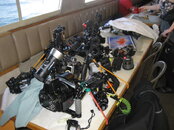I would argue (from an aerospace background) that actually it's not a moot point. Fire is a risk, so adequate escape should be provided (as well as preventative measures, warning - alarms and fire suppression)
So I would say the cause of the fire is secondary, The primary being; was their sufficient warning to the passengers, and what prevented their evacuation
I've worked with the NTSB on air crash investigations in US so know they'll be very thorough.
What stands out to me straight away from the picture in post #45 from
@elgoog is how narrow and insufficient the gangways are. It's a dead end one way and, in the middle of the night, if awakened everyone trying to get out of bed at the same time (some possibly getting belongings). If passengers near the exits on this boat were overcome with noxious fumes (assuming they were awake) then that would block that route.
GRP boats burn fast
With an aircraft you have multiple routes and exits, you can go over the seats if you wish For the A 380 we evacuated 850 passengers in
78 seconds (less than 90 seconds is the required time), with 50% of exits made unusable.
The plane had debris in the aisles was dark and we pumped smoke in just to make it that little bit more difficult as an additional incentive we offered hard cash $50/$100 notes to the first X many people off to encourage a less orderly (more "panicked) departure for test "passengers"
This will have impacts on US boats for sure, no doubt with new legislation being implemented and boats being pulled out of service for non compliance, with OP's not being able to afford to replace them




